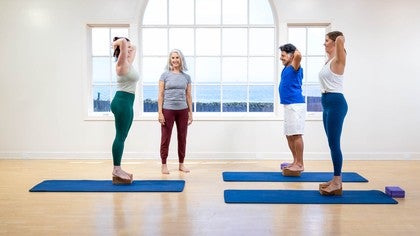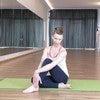Description
About This Video
Transcript
Read Full Transcript
Okay, this is Johnny who I'm going to be working with. And I'm going to just tell you a little bit about his health history. So 11 years ago had a left hip replacement and was scheduled to have a right hip replacement six months after, but he chose not to have that replacement because he was able to continue to do all the activities he loves to do. And those activities are two hours of singles tennis every day, 400 miles a month on a mountain bike in the Hills of Santa Barbara. And if you don't, haven't seen that, you should look on Google Maps because they're quite high.
And martial artist also, he's a professional hip hop dancer. So isn't that amazing for lumbopelvic hip complexities of movement. So there's a lot of motion there. And in college you were a wrestler too. So lots of athletics, lots of strength.
So it'll be super interesting what we'll see. I have trouble putting my socks on. Oh, he has trouble putting his socks on. Okay. But you're pretty good at getting on and off the floor.
Yeah, well. Okay. All right. So we're going to start with the assessments. All right.
So you're going to take your hands and you're going to place the top of your hands on the top of your pelvis here and point your fingers towards your pubic bone. Exactly. And then just rest your hands there. Now in your own felt sense, I mean, tell me if you can feel whether or not one hand is slightly in a different position than the other, and maybe you don't, maybe you do, what do you feel? Not really. Okay. Look down at your hands.
Does it appear that one's more forward than the other? Yeah. It looks like your left one. Yeah. So some people can feel the difference in that and then you can actually visualize it and see it. So yeah, his left innominate is more forward or we would say anterior and the right one's a little more posterior. So there could be a tendency to want to have a pelvis that likes to face to the right.
Okay. So turn, face the window. Good. And bring your arms down. Okay. So now we're just going to notice him his stance. All right. Where is his weight primarily on which leg left leg or the right leg.
So it does appear that his weight is more on that right leg, but there's kind of some other stuff going on in the spine, you know, that makes it perhaps a little bit more difficult to see, but you can see the tip of the shoulders, you know, which is an indication of the ribs. And I can feel it, you know, it's more prominent on this side than this side. So we have a little bit of a shift of the ribs to the right. Okay. And then we're going to do cross your arms and I'm going to do, we're going to do a little hip drop here.
So keeping your foot flat on the floor, just slowly bend your right knee. There we go. That's very nice. He kind of likes that. Okay. And come back now let's do that on the left. That's the left hip replacement, remember?
Yeah. So it's a little sticky. It doesn't really like to go down too much, but you're also rotating your, you know, your pelvis around a replaced hip. So this bend the right one more time. Yeah. So stay there for a second. I'm gonna take my hands away.
He really likes this position. You see how much his ribs shift to the right here. And that's how he's achieving this motion. Come back. So I'm going to actually hold your ribs here. Let's see. I'll do it this way.
All right. Now, very slowly bend your right knee. Okay. Stop. So that's really what you have in an order to really drop your hips. So keep bending your knee, then you have to do this kind of shift like that. And then you're shifting into, as you can see this hip here. Okay. And come back, that's probably one of your moves, right?
Yeah. Got it. Okay. All right. Enough moves. Okay. So now we're gonna, I want you to bend the left knee again, and we're going to say that's a little more difficult and you actually have to push out in your hip here so that's probably the restriction in your right hip here. That's, you know, you're having trouble with that. Yeah. Okay.
Bone on bone, right? Exactly. So that's, yeah. It's hard for your pelvis to move around that femur. So then he has to shift through here. Okay. And come back. But it's also his dance form, you know, the dance form is doing, you know, through that.
Okay. So now place your hands on the sides of your pelvis. And what I want you to do is just shift your weight to the right. So you can kind of push with your hands a little bit kind of shift. Yeah. Okay. And then coming back to the front and then shift to the left.
Okay. And coming back. So when you shift to the right, okay, go ahead and shift to the right. Again, the ribs really kind of lead through there to the right. All right. And what we want to be able to see when you shift to the right is actually this left hip dropping a little bit, which it doesn't like to do.
Yeah. And the ribs shifting in the opposite direction. So he kind of does the reverse of what we want to see. Yeah. But the only way you can do that is side bend. So that's okay. We just want to notice the movement pattern. Cause we're trying to see what your movement pattern is.
All right. It's nothing that's good or bad. It's just, how is it that you strategize your movement? How does that work for you? You know, and then by creating some, you know, a little bit of change to your pattern will actually ease up and allow your movements like playing tennis or whatever, to actually feel a little bit easier and freer maybe even stronger. Okay.
So that's pretty good. We're going to begin by getting on the mat. So come lie down. You're going to lie down on your side and we're going to do both sides. Okay. I'm going to give you a block for your head to support your head. Okay.
Is that okay? All right. Great. Now bend the top knee for me. And we're going to put the roller on your leg. Good. So, I want your knee on the roller and your ankle on the roller. Very good. And let's straighten this leg here.
Great. Okay. And then just stack your shoulders. So one's on top of the other and we're stacking the pelvis on one side on the other. Okay. So this looks pretty good. So what I want you to do is reach with your knee so that the roller is going to move away from you.
So you're going to kind of do that. So that's that pelvic rotation to the right. Good. Now think of your leg bone, your femur, coming into your socket, kind of suck it in and bring that pelvis back. Yeah. So reach again. Very good, Johnny. Yeah.
Pull the knee in and feel your pelvis stack again. Good. And just repeat that reach and pull the knee in. Very nice. Keep going, reach, pull the knee in. We'll do two more reach. Pull the knee in one more.
Reach. Pull the knee in. Okay. Now place your left hand behind your head. There you go. And let's bring the elbow up towards more of the ceiling.
Okay. Not behind you. Now, I want you to just lean gently into the floor and just turn your chest now without moving the roller towards the ceiling. So you're going to rotate back and you can let your head go. Let your ribs move. There we go.
And now feel your ribs. Start at the bottom of your ribs and roll your ribs back to where you were on your side. Okay. And again, lean into the floor, turning your rib cage. I'm trying to get the whole rib to come. I know.
And then bring that back to where we're going to think about this line between your rib and the opposite hip here. Okay. So lean into the floor. Try not to lead with your elbow. Try to lead with your ribs. There you go. And then exhale, come back. Feel this connection between the hip and the rib.
Let's do two more reach and rib come back. That's it. Good. One more. And come back to your side. Now pause here for a second. I'm going to put my hand right here on your sit bones.
Can you push into my hand a little bit? Yep. Without going forward, do you feel how you went forward? And this is the hip drop, try to push on my hand here. Drop down. Push right here. There you go.
I know. That's good. Can you keep that activity and do the roller forward, but keep pushing here. Do the roller away from me. Yeah. It's okay. Twister. Exactly. Exactly good.
That's it. And then pull the knee in. Now we're going to add the ribs with it. So reach the roller turn towards the ceiling. Just small. Come back in. Let's do less pelvis and more ribs. Okay. So ribs.
Nice. And then pull them in together. Bring the shoulder back. You have to make sure you come back. Yeah. Now ribs go roller. Just easy. Yeah.
So should be pleasurable and come back. I know who's definition of pleasure, right? Okay. Keep going couple more. I want a couple more here. Ribs, ribs. There you go.
And come back together and lengthen and come back together. Really good. Okay. I want to do it on the other side. So let's flip of course. A little slip.
Okay. So the bent knee on the roller and the ankle on the wall, on the roller. Good. All right. Perfect. All right. Let's stack you first. Good.
So you remember the shoulders, the elbows straight to the ceiling? Yeah. Okay. Now let's pull the roller in just a little bit. Okay. Now I still want to do this same thing cause you tend to hike your hip a little bit. So just push on my hand a little bit here.
So this is coming down this way as best you can. That's the idea it's just to keep contact here. Can you just keep, you don't have to push hard. Just keep contact with my hand and now roll the roller away and then think of the leg shortening. Pull the knee into the hips and bring the pelvis back. Good.
And keep contact here as you go really nice and draw it in. And you can think of the left side of your ribs, really sinking into the floor. Cause that's where your rib cage doesn't like to go. So try to keep your ribs sinking into the floor. That's it. And pull the knee in.
That's far enough. Yeah. Pull it in. Good. And again, that's far enough and pull in and lean into the floor. That's it. Without losing contact here. Push on my hand a little bit. There you go.
And draw it in. Just lean into the floor. Good. Now pause here. And now you're going to do the rib cage. So towards the ceiling and as you do that again, think of the ribs on the mat, like lean into the floor. Yup. And bring it back.
Good. And again, lean into the floor and find that diagonal from the rib to the opposite hip as you come back. So we're working the obliques here and again, really nice and pull and again, Really nice Johnny. One more time. Okay. Now we're going to ring you out like a washrag and we're gonna do both. You got it.
Go ahead. You know the movement now reach and I'll pull everything together. Pull it together, Johnny, will you please? Yeah. And reach. And pull, that's it keep contact here.
Don't over effort. There we go. Keep contact here. As you go pull in. That's it pull in, pull in, pull in, pull it. That's it one more. And pull in and take a rest.
That was really terrific. Okay. So now we're gonna move to the wall. Great. So we're going to start with your feet on the wall. And what I want you to do at first is just think of your feet as like suction cups and you're going to kind of press into the wall. Exactly.
So you feel that and to feel that activity. And then the second action I want you to add is like dragging without moving your feet, push your heel down into my hand. Yeah. So pull down and you're going to feel that activates your hamstrings. Right? Okay. Now relax that for a second. All right. And do it again.
Push like suction cup your feet into the wall and then drag it down the wall. So you're kind of pushing. Exactly. So we're creating isometric contraction, right? And then relax. Okay. Now I'm going to add this block here. That's a little heavy, so very good.
Now you're going to hold the block like it's an egg, so you want to engage it, but you don't want to break it. Okay. So now press into the wall. Suction cup, your feet, drag your heels down the wall and engage the block and then just breathe normally. Just kind of have a nice, easy breathing and hold and then relax. All right. That's the exercise.
So feed into the wall, drag your heels down the wall, engage the egg, but don't break it and breathe. Just do easy, nice, easy breathing. That's it. Good and exhale. You can relax. So let's do that the way you're doing it.
So we'll engage the isometrics and then you'll take like two breaths and then on the end of the exhale, you can relax. Okay. So feet, that's it breathing, engaging the isometric. So what we're doing, you can just keep repeating that. And then when you exhale, you relax. So we're engaging the legs, engaging that connection between the feet, the inner thighs into the hip joint, with the breath.
So we're, I'm, intentioning here that we're taking care of activating the pelvic diaphragm through this activity here, the activity of breathing and the activity of the isometrics of the feet on the wall and the adductors. If you remember back from the anatomy section, that should feel good. Okay. Now the next time, your next exhale, you're going to exhale and then do a small pelvic tilt off the mat. So you're going to kind of lift that's great. And there's hang there for a second. Take another breath.
And as you exhale, stay there and let your ribs just sink into the floor, but keep your butt up. There you go. And exhale. Feel your ribs, sink into the floor. One more time, take a breath, then sink into the floor and then roll your pelvis back down and relax. Okay, we're going to repeat that. Suction cup your feet dragged the heels, engage the block.
Exhale. Curl your pelvis. Nice, Johnny. Really good. Now just hover there. Your pelvis is hovering. It's just kind of floating up there as you deepen your exhale and let your ribs sink.
Oh, this is getting so much better. Great. Keep going. Breathe in. And nice exhale saying the ribs. Very nice. One more time. And then as you exhale, you're going to roll back down.
All right. Let's do one more repetition. Feet engage plus your feet, on your feet are on the wall. You're pushing all your toes into the wall and dragging your heels. There you go. Now you're hovering the pelvis. This is great.
You're going a little higher each time, which is awesome. Stay there. And then you work that exhale. Stay up, stay floating in the pelvis. That's it. And the ribs kept, keeps sinking.
Good exhale. We're gonna do one more breath and roll it down. That was really terrific. Okay. Now we're going to switch to lying on your side again, but I want your head here where you are just, and I want you to straighten your legs and I'll give you this for your head. Great. And we're going to, can you be close enough to the wall that you can put your top leg on the wall and we can bend the underneath leg so the knee can come towards me.
Yeah. This knee can bend. This doesn't need to be on the wall. Okay. That's it. We want to have one leg on the wall. Exactly. Very good.
And we're going to stack that pelvis again and you could put your hand behind your head, this one. Yeah. And then bring your head back. So it's in line on the block. Okay. So just look straight out that way. Okay. And then we have the ribs on top pelvis on top.
Good. And then I want you to push into the wall. Let's bring your foot up. Just a little higher. So I want the foot at the height of your hip here. And then I want your toes to come up towards the one. So it's going to feel a little weird. Yeah.
So I'm looking for like a parallel line here of the little toe. Yeah. So you feel how that engages through here? Is that okay? No discomfort. Okay, good. So what I want you to do is push your heel into the wall. Like you're trying to push the building away from you, that's it.
And that's creating that length and you can reach an opposition through this elbow. So it creating that length of the tautness of the thoracolumbar fascia. Okay. Now you're going to keep that activity. And all I want you to do is lift your, without bending your knee. Just lift your heel off the wall and then lift the heel.
Just the heel. That's it. It's going to go this way. It's going to hike your hip up. It's gonna shorten that's it. Now push into the wall with your heel. Does that bother you? Is this comfort just hard?
Okay. Never done it before. Okay. That's good. You did great. Now lift the heel up and you feel how your pelvis comes up towards your ribs. That's a hip hike and I'm sure you do that a lot in your dancing and push into the wall.
A lot faster. A lot faster. Exactly. Well, we're going to do this slowly. That's it. And then reach because you know, your fascia is going to respond to slower movement, then the faster movement. Yes. And then reach. And this is what we're trying.
I'm trying to get you to glide and move. This is getting so much better Johnny and reach into the wall. Good. Pull it. This is the replaced hip. Exactly. But your spine wasn't replaced so we can move and work that yeah. And it's activating.
Can you feel that the lateral hip? Yeah. Very good. This is excellent. Excellent. And then push into the wall. Excellent. Yep. Pull. And we're getting obliques.
We're getting the whole package here. Obliques. This is awesome. This is a really a good one for you. This could be part of your daily routine. Fit it in your day with all your activities and one more time and then push it away.
That's terrific. Other side. Okay. And bend this knee. Bring it up a little bit. Let's stack your hips.
Yeah. Can we bring your shoulders back behind your let's bring the block back. Pelvis is good. And then your foot good. Bring it forward a little bit and up there. Okay. So this is the right hip and let's bring the elbow forward just a little bit.
So if you think of your t-shirt here, We want to see that there's like a length. I'm going to take the wrinkles out of your shirt here, like that. Okay. And let's rotate your pelvis forward just a little more. If we can, without your ribs going, can you lean? There you go. Push here.
Push here. Push here. Push here. Push here. Push here. That's it. That's good. Okay. Now push your heel into the wall.
Awesome. And now lift the heel up. Keep your knee straight and you're lifting and hiking up and push your heel into the wall. Really nice Johnny and up and reach, and up. Keep reaching through that elbow. Reach away. Good. Yes.
And hike. So you feel like you have a little more movement on this side then the other side? Yeah. And reach, keep going. Yep. And then keep leaning into the floor here with your ribs, right into the floor and reach, keep going, push into the wall with your heel.
It's like flossing. Can you imagine like you're flossing your hip here in and out so you can do that kind of oscillation. Yeah. There you go. Very good. Yeah.
And reach up and reach. Let's do two more up and reach last one up and reach you made it. Okay. And rest. Okay. So now we're going to stand up and I'm going to do a few moves that you might feel a little familiar with. Okay.
I'm going to have you come and stand on the mat a little wider than hip distance. Good. And then just make your feet, whatever. Comfortable. If it's slightly turned out or whatever you'd like to do. Good. So I'm going to ask you to do a squat, but a hip hinge. So I want you to sit back kind of folding at your hip.
Yeah. And then stand up. Okay. And do what's comfortable without a discomfort. Okay. Good. Now, as you bend, can you feel the weight go to the outer part of your feet to the little toe side of your feet? Yeah. And get your knee to track over your third toe.
So you can get your knee to go over your third toe right now, your knees are tracking over your big toe. Can you think of opening the knees a little bit? So you roll to the outside of your feet. Now don't turn your feet out. You may want to turn out your feet a tiny bit.
That might be how it's going to there. So for you, when you do a little squat, you're going to want your feet a little turned out. Try not to keep them parallel. That looks great. Okay. Good. Easy, good.
Don't force it too. You don't want to get to a place where you're like hitting a wall with it. You want some buoyancy in there. You want some, yeah. You can bounce a little bit. That would be good.
Yeah. Yeah. That's right. Okay. Now go into that little squat and stay there and you can place your hands on your thighs. All right. And what I want you to do is you can arch your tail to the right and to the left you have. So I'm sure you're familiar with that. Right?
Good. Right and left. There you go. Good. Good. Keep kind of sinking into that. Okay. And now come back to the middle and then stand up. Okay. And again, go down.
Track your knees again for me at the third toe. Now what I want you to do is shift your weight to the right and lift your foot up and then change your mind and go, nope I want to shift to my other side. That's it. And shift. You got it. Shift and shift.
That's it. Okay. Shift. Now how about getting that rib to go to the left? Right's good. How about left shift of your, there you go. So I'd like to try to get you to shift to your left with the ribs left.
That's hard. It's a balance on that left hip. I know. Good. And a pause here. Can you shift to your left? That's it try not to lift the shoulder, but just yeah. Drop your right hip a little bit. Go ahead.
So you're really great at right translation. Translate left and then come back. So minimize your right. Just minimize it, but exaggerate your left. There you go. That's it. And how's your head doing that? Does your ear go to the left. There you go.
Ear to the left, ear to the right? Yeah. And left. That's it Johnny. Good. And right. And one more time. And here we go. Okay. Take it out.
Okay. All that control too much control. Too much control. Yeah. Okay. So come step here. Okay.
No, the it's a, those subtle movement. I don't know if you want to move around. Do you feel any difference from just that the movement that we did and like do, do something that can you, I mean, do you feel like it's a little bit easier for you or, you know? Yeah, yeah. Yeah. Be honest.
There you go. Yeah. Okay. Oh no. Okay. Now back to our assessment, what a contrast. This is wonderful. Okay.
Hand on your pelvis, how do we do right? Look back. Yeah. It's back. It's really back. It's crazy.
That's awesome. Yeah. Exactly. Just from that. Yeah.
How long does it last? Gotta practice. Okay. Turn and face that way. It's not forever. I always say what's forever. There's nothing forever, really plastic maybe. Okay.
Yeah. Unfortunately. Okay. So let's take a look at your, just your stance. Okay. First of all, look how he's organized through his trunk, now. It's much better. It's not shifted to one side. He also had, remember I said it was quite, it's more developed.
I mean, it's not like the musculature. He is stronger here than here in terms of muscle tone. But the idea that his ribs have shifted to the left has filled up this space here. And it's given more tone to these muscles that he didn't have before. And your less arch actually.
Okay. So bend your right knee slowly. That's it. And come back that let's not do rib translation and that's a movement that you're really used to. Yeah. Come back, come back up. Yeah. Okay.
So it's very small. Bend your right knee. There it is right there. And cut. Straighten your leg. So can you feel how this side is only your pelvis as you bend the right knee?
It goes down there it is. You feel it? Yeah. That's perfect. Okay. Let's do the other side. Yes. You feel that ease the lower back.
Yeah. Way more here. That is wonderful. Seeing that motion. Okay. Let's do the swaying. Put your hands on your greater trow cantors.
Yeah. Okay. Come stand up. Okay. Come back then. Might it better to you. I don't know. Do you feel more bounced when you do that from right to left?
When you're doing that in terms of your hip joint, you know the shift. (indistinct) But you want to shift the weight. Exactly. Exactly. You can shift the weight and then add the little butt swing shift, but shift your weight. Oh, that's more (indistinct).
Really? That's that's actually yeah. Shift the weight and yeah. No, it looks good. Yeah. You have to explore the movement that you're really familiar with and what you're doing. So I think we were successful.
Yay. You think? (indistinct) Okay. Yeah do. That'd be great. Okay. Thank you. Thank you.
Pelvic Health - Playlist 1: with Madeline Black
Comments
I happen to know Johnny (my love) lost in tennis that night. He said he was "too loose." What was amazing to me was he didn't mind because he felt so good! You're a great teacher Madeline!
You need to be a subscriber to post a comment.
Please Log In or Create an Account to start your free trial.













 for all series
for all series








